|
AMERICAN INDUSTRIES—Baldwin
Locomotive Works — Scientific American—May
31, 1884
THE MANUFACTURE OF LOCOMOTIVES.
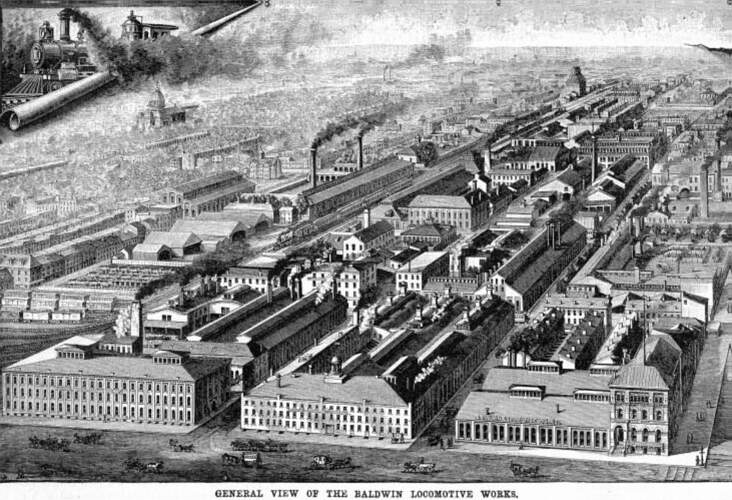
It has been a common remark, in connection with any disturbance
of the money market since the war, that the country was building
railways too fast. Ten million dollars a day was the estimated
cash outlay on this account, according to Poor's Manual, for the
three years up to the close of 1882, with a capitalization of
nearly double this amount. Yet it was a felicitous comparison
which suggested that even this great investment hardly exceeded
that which either of three of the great powers in Europe annually
expended in the maintenance of armies and iron clads in times
of peace. The nation, as a whole, may therefore be truly said
to have been putting only a moderate portion or its surplus into
this most effective way or hastening the further development of
its own resources, and though this may have afforded the opportunity,
it has been in no way the cause, of any Wall Street panic.
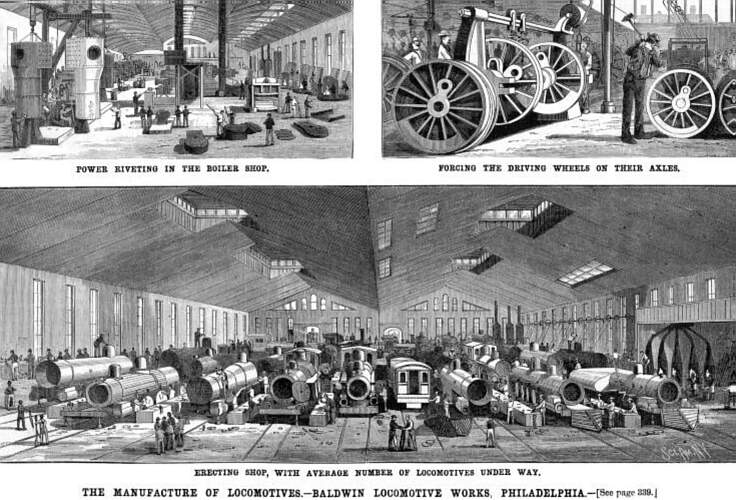
Side by side with this enterprise in railroad building, at
once caused by and promoting it, has been the wonderful growth
of every industry pertaining to the equipment and operation of
railroads. There were a few locomotives imported in the infancy
or railroad building here, which met with only indifferent success,
but our own inventors and mechanics early began to take the lead
in this branch of manufacture and in car building, which they
have ever since held. The locomotive of today is one of
the most wonderful of all the products of man's skill, and has
reached a point of perfection from which it seems hardly possible
to attain further progress, so long as we obtain power from coal
and wood according to principles now understood.
It is in itself an epitome of modern technical skill, representing
almost numberless inventions, and the illustrations we to day
give, of the largest locomotive manufactory in the world, speak
also of a history of its development during half a century.
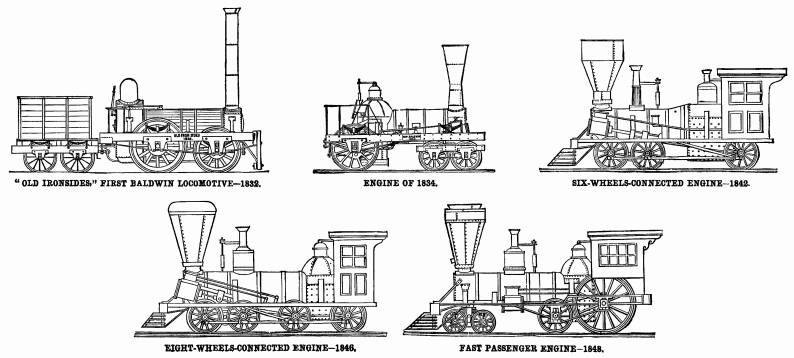
The Baldwin Locomotive Works, at Philadelphia, had a humble
beginning. Matthias W. Baldwin, the founder, was a jeweler and
silversmith, who, in 1825, formed a partnership with a machinist,
and engaged in the manufacture of bookbinders' tools and cylinders
for calico printing. Mr. Baldwin then designed and constructed
for his own use a small stationary engine, the workmanship of
which was so excellent and its efficiency so great that he was
solicited to build others like it for various parties, and thus
led to turn his attention to steam engineering. In 1831 he built
a miniature locomotive, for exhibition, which was so much of a
success that he that year received an order from a railway company
for a locomotive to run on a short line to the suburbs of Philadelphia.
The difficulties attending the execution of this first order were
such as our mechanics now cannot easily comprehend. Tools were
not easily obtainable; the cylinders were bored by a chisel fixed
in a block of wood and turned by hand; the workmen had to be taught
how to do nearly all the work; and Mr. Baldwin himself did a great
deal of it with his own hands. It was under such circumstances
that his first locomotive, christened Old Ironsides, was completed
and tried on the road, November 23, 1832. It was at once put in
active service, and did duty for over a score of years. It was
a four-wheeled engine, weighing a little over five tons; the driving
wheels were 54 inches in diameter, and the cylinders 9½
inches in diameter by 18 inches stroke. The wheels were of heavy
cast iron hubs, with wooden spokes and rims, and wrought iron
tires, and the frame was of wood placed outside the wheels.

The boiler was 30 inches in diameter, and bad seventy-two copper
flues 1½ inches in diameter and 7 feet long. The price
of the engine was to have been $4,000, but only $3,500 was actually
paid for it by the railroad company. The Ironsides attained a
speed of thirty miles an hour, with the usual train, and was said
at the time to be superior to English locomotives then made, on
account of its "light weight, small bulk, and the simplicity
of her working machinery."
In February, 1834, Mr. Baldwin completed his second locomotive,
for a railroad in South Carolina. In it was embodied a "half
crank" improvement which he had obtained a patent for, by
which the boiler could be made larger and placed lower. The driving
wheels were made of solid bell metal, the combined wood and iron
wheels previously used having proved objectionable, and Mr. Baldwin
obtained a patent for a cast brass wheel, his idea being that
by varying the hardness of the metal the adhesion of the drivers
on the rail could be increased or diminished. The brass wheels
soon wore out, and no others of the kind were made, but the general
features of this second locomotive were followed in most of the
machines built by Mr. Baldwin for several years. The valve motion
was given by a single fixed eccentric for each cylinder.
Five locomotives were built in 1834, when the new business
was fairly under way, and in 1835 a building was erected for the
works, which occupies a part of the present site on Broad Street,
this original structure now forming the storeroom, boiler shop,
and principal machine shops. All these engines built in 1834 had
several patented inventions of Mr. Baldwin. They had the half
crank, ground joints for steam pipes, and the pump formed in the
guide bar, four-wheeled truck in front, and a single pair of drivers
back of the fire box. The English engine builders were then making
steam pipe joints with canvas and red lead, which would only permit
of their carrying a pressure of some sixty pounds of steam, while
Mr. Baldwin's locomotives were worked up to twice that pressure.
In the six years from 1835 to 1840, inclusive, 152 engines
were turned out at the works, and, though there were not many
changes in design, there was a call for larger engines. Three
sizes were built: 12½ by 16 inches cylinder, weighing 26,000
pounds; 12 by 16 inches cylinder, weighing 23,000 pounds; and
10½ by 16 inches cylinder, weighing 20,000 pounds.
In 1842, Mr. Baldwin patented what has since been considered
the greatest of his improvements in engine building, the six-wheel
connected locomotive, with the four front drivers combined in
a flexible truck. The first engine of this class weighed twelve
tons, and its performance was so successful that orders for similar
ones came in rapidly. The adoption of this plan of building also
led to the immediate increase of the weight of locomotives, and
in 1844 several were built weighing eighteen and twenty tons.
In 1845 the present design of four drivers and a four-wheeled
truck was adopted. At first the half crank was used; then horizontal
cylinders inclosed in the chimney seat and working a full-crank
axle, and eventually outside cylinders with outside connections.
In 1848, Mr. Baldwin took a contract to build for the Vermont
Central Railroad, for $10,000, a locomotive which would run with
a passenger train at a speed of sixty miles an hour. It had one
pair of driving wheels six and a half feet in diameter back of
the fire-box, and the cylinders were seventeen and a quarter inches
in diameter and twenty inches stroke. This engine was used on
the road several years, and the officers stated that it could
be started from a state of rest and run a mile in forty-three
seconds.
A prominent feature in the conduct of the business of the Baldwin
locomotive works is the extensive use of standard gauges and templets.
An independent department of the works, having a separate foreman
and a force of skilled workmen, with special tools, is organized
as the department of standard gauges, where gauges and templets
for every description of work are made and kept. The original
templets are kept as standards, and never used in the work itself,
but from them exact duplicates are made, which are issued to the
foremen of the different departments. The working gauges are compared
with the standards at regular intervals, in order to secure absolute
uniformity in every detail. Frames are planed and slotted to gauges,
and drilled to steel-bushed templets; cylinders are bored and
planed, and steam ports, with valves and steam chests, finished
and fitted to gauges. Tires are bored, centers turned, axles finished,
and cross-heads, guides, guide-bearers, pistons, connecting and
parallel rods, planed, slotted, or finished by the same method.
Every bolt about an engine is made to a gauge, and every hole
drilled and reamed to a templet, so as to secure uniformity and
interchangeableness of parts. This system had been developed and
perfected previous to the death of Mr. Baldwin, which occurred
in 1866.
The heaviest locomotive built at the works up to 1878, and
one of the heaviest ever built, was for the New Mexico and Southern
Pacific. It was of the "Consolidation" type; cylinders,
20 by 26 inches; driving wheels, 42 inches diameter, four pairs
connected; one pair truck wheels, 30 inches diameter; capacity
of water tank on boiler, 1,200 gallons, and of tender 2,500 gallons;
weight of engine, including water in tank, 115,000 pounds, and
weight on driving wheels 100,000 pounds.
The works, when running full, give employment to 3,000 hands,
and are capable of turning out 600 locomotives a year. Their actual
production for the last forty-two years has been as follows:
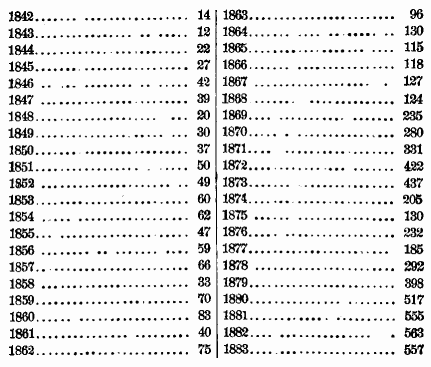
There are about 15,000 locomotives of all kinds in actual use
in the United States, the Pennsylvania Railroad leading with over
1,100, the New York Central coming next with 700, after which
come in order Chicago, Milwaukee, and St. Paul, Baltimore and
Ohio, Erie, Chicago and Northwestern, Philadelphia and Reading,
and Chicago, Burlington, and Quincy—each with more than 500.
The Baldwin locomotive works has furnished a large proportion
of all these, but it has further made locomotives for almost every
country in the world. Russia has been a liberal purchaser, many
have gone to Central Europe, Australia has many of these American
engines, and South American roads have been principally supplied
from here.
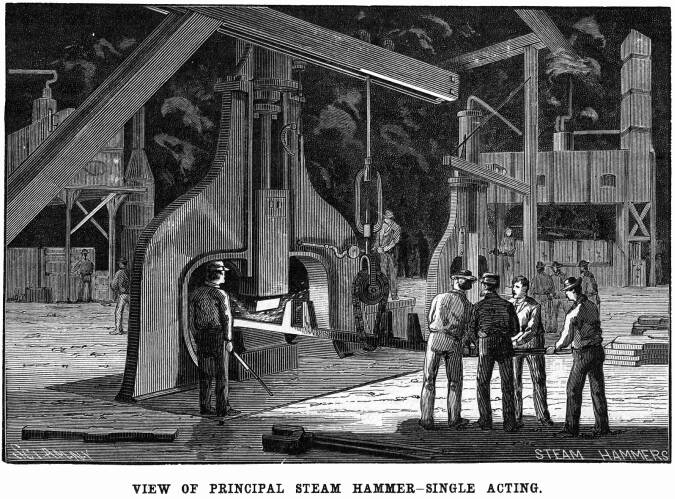
The area covered by the works, on Broad Street, Philadelphia,
is rather more than nine acres. The view of the erecting shop
shows a great number of locomotives under way, but it is only
a faithful representation of the scene when our artist visited
the works, and gives only a fair idea of the average amount of
work in hand. This immense production gives the firm great advantages
in the filling of orders promptly, and the fact that all parts
are made interchangeable renders it possible for the purchaser
to keep the expenses for repairs at a minimum, by keeping duplicate
parts of pieces likely to break or wear out, or by ordering them
as needed from the works. In the boiler shop, while there is some
riveting done by hand, power machines are mostly used therefor,
and the view of the wheel department illustrates the forcing of
the driving wheels upon their axles. The steam hammer shown is
one of several of the same kind in the works. It is single acting,
7,000 pounds weight of ram, drop four and a half feet, and piston
rod five inches diameter.
The firm as now constituted was formed in 1873, under the style
of Burnham, Parry, Williams & Co.
Build a Locomotive
| Contents Page
|







